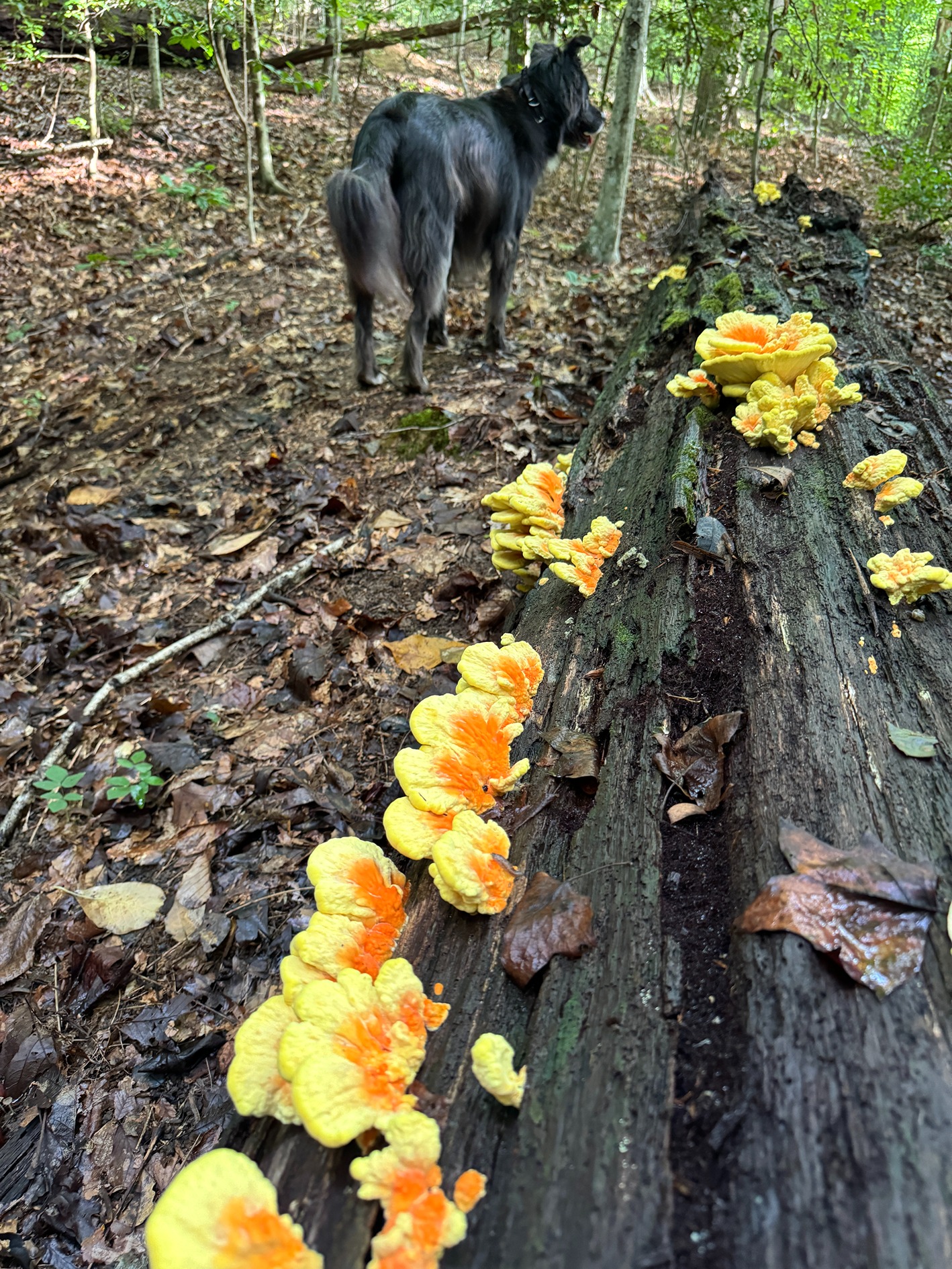The (Very Slow) Race to Move Forests in Time to Save Them

Trees have always migrated to survive. But now they need help to avoid climate catastrophe.
I drove to Oregon because I wanted to see the future. Our rapidly changing climate vexes me, keeps me up at night—perhaps you’ve felt this, too—and recently I’d become particularly preoccupied with trees. In California, where I live, climate change helped kill nearly 62 million trees in 2016 alone, and last year, 4.2 million acres of our state burned. I wanted to know what was in store for our forests and, because we humans rely on them for so much—for clean air, for carbon sequestration, for biodiversity, for habitat, for lumber and money, for joy—what was in store for us.
I’d read about a group of scientists who were not only studying the calamities befalling our forests but also working to help the trees migrate in advance of coming doom. So in May, I headed to a 3-and-a-half-acre stand of roughly 1,000 Douglas firs at a US Forest Service nursery outside of Medford. The grove was situated in a wide valley in the southwestern corner of the state, nestled between the Cascades to the east and the Coast Range to the west. Brad St. Clair, a Forest Service scientist who has studied the genetic adaptation of trees for more than two decades, met me by the road. He’s short and rugged as if built for adventuring and tending to the lives of trees, and he arrived in a souped-up Sprinter van loaded with an armory of outdoor gear. In 2009, he and his team planted this and eight other stands of firs after they’d gathered seeds from 60 tree populations all over Washington, Oregon, and California and grown them into seedlings in a greenhouse. The seeds were sourced from as high as 5,400 feet in the Sierras and as low as the coast, from Mendocino County, California, all the way north to Central Washington, and were planted in intermixed clusters at each of the nine sites to see how they would fare in a hotter, drier climate than the ones they’d come from. In other words, to see if they’d make it in the future.
Douglas fir, a tall, narrow-trunked evergreen often dragged indoors for Christmas, is a favorite of foresters and logging companies because of its combination of strength, fast growth, and pliability. It can also withstand a change in climate of about 4 degrees Fahrenheit without much trouble. But global average temperatures have already risen by almost 3 degrees since the 1900s, and all models predict average temperatures to blow through the 4-degree threshold in the next several decades, perhaps rising above 7 degrees by the end of the century.
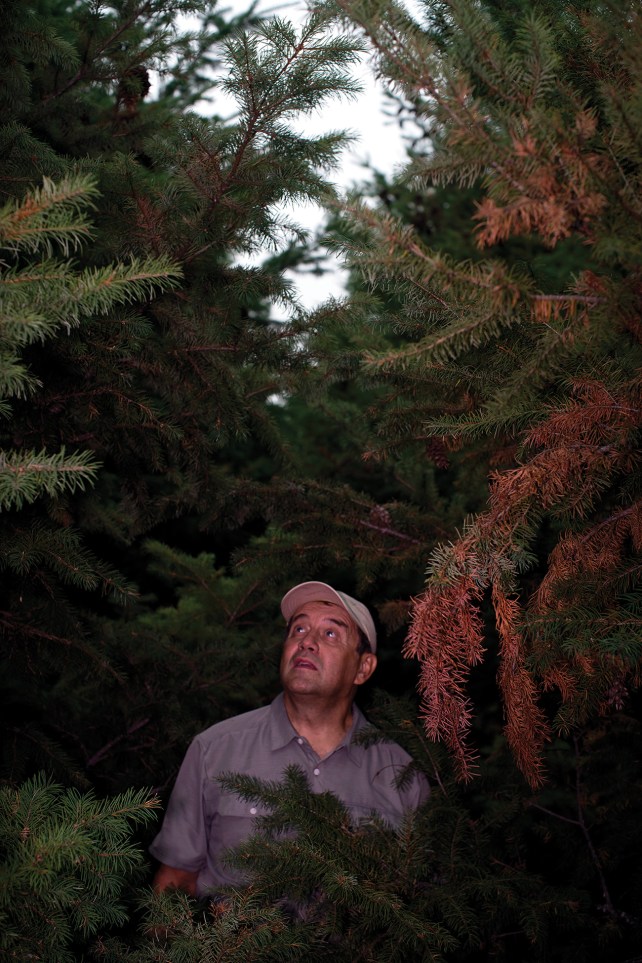
In the wide, flat expanse of the nursery, the firs were rimmed by fallow land on all sides. St. Clair instructed me to put on safety glasses, and then ducked down, pushed aside the outermost branches, and slipped into the trees. I followed him. Within two steps, there we were in a veritable, dense forest as if an enchanted wardrobe had been pulled open to reveal a world transformed. On the periphery, it had been hot, but here, as we moved through the dapple, it was cool and fragrant with pine.
A sign mounted on a PVC pipe marked the provenance of the cluster of trees we stood beneath. They came, St. Clair explained, from the Oregon Siskiyou, a dry zone at only slightly higher elevation than where we were today. This is why they were doing so well: Their native climate wasn’t so different from Medford’s. As we moved on, the trees, while still lush and full, grew shorter. Because this next batch was from up in the Cascades, he pointed out, at an elevation far higher than where we stood, the trees were somewhat stunted in this new habitat and couldn’t grow as tall. We kept walking, and after a while the trees grew taller again, looming three times my height before breaking into the sky. These trees also came from climates that were dry like Medford, and so found here a happy home—at least for now.
We ducked and trudged through the lower thickets of the healthy trees until we suddenly emerged from the woods onto what I can only describe as an arboreal apocalypse—an open tangle of dead branches, brown and brittle, like an upright graveyard. These ill-fated trees, St. Clair said, had come from the Oregon coast, where it is far wetter. While they’d done okay in the first three years of the study, they just couldn’t make it in the long term. “As the climate warms,” St. Clair said, looking around and pointing up to a dead fir with his walking stick, “you’re going to see more of this.”
The future of forests is a grim one—too grim for some of us to bear. By 2030, 75 percent of redwoods will disappear from some of their coastal California habitats. In some climate scenarios, almost none of the namesake species in Joshua Tree National Park will exist. Sea level change is creating ghost forests all along the Eastern Seaboard—already, less than a third of New Jersey’s Atlantic white cedar habitat remains.
Like humans, forests have always migrated for their survival, with new trees growing in more hospitable directions and older trees dying where they are no longer best suited to live. The problem now is that they simply can’t move fast enough. The average forest migrates at a rate of roughly 1,640 feet each year, but to outrun climate change, it must move approximately 9,800 to 16,000 feet—up to 10 times as fast. And in most habitats, the impact of highways, suburban sprawl, and megafarms prevent forests from expanding much at all. Forests simply cannot escape climate change by themselves.
Back in 1992, forest geneticists F. Thomas Ledig and J.H. Kitzmiller coined the term “assisted species migration” in a seminal study in the journal Forest Ecology and Management. Since then, hundreds of biologists and geneticists like St. Clair have been studying how best to move forests in advance of their looming destruction. To do so requires a complex set of mapping and experiments—understanding, for instance, what climate trees are best suited to grow in, what region will most closely resemble that same climate in, say, 50 years, and what adaptations best ensure that a tree will take root and flourish, build symbiosis with the soil fungi, and not end up a mere matchstick awaiting the next mega fire.
St. Clair is something of an assisted migration evangelist, a firm believer that we need to move tree populations, and fast if we want to keep apace. But due to bureaucratic logjams and a fervent commitment to planting native species, there’s very little assisted migration in the United States— unlike in Canada, where the practice has been adopted with more urgency in recent years. St. Clair and other Forest Service scientists are working to transform assisted migration from a mere research subject to a standard management strategy in our vast, imperiled public lands.
We finished our walk through St. Clair’s baby forest, making our way back to the cars along its outer edges. “The future is terrifying,” I told him. He understood what I meant, he said.
During the talks he gives about his research, he likes to show an image from Lewis Carroll’s Through the Looking-Glass, in which the Red Queen charges forward with her crown and sturdy scepter, pulling frenzied Alice along in her wake. He had the slide printed out and handed it to me as we walked. “Now, here, you see,” the Red Queen says to Alice, “it takes all the running you can do, to keep in the same place.”
“So that’s what we gotta do,” he told me, pointing to the Red Queen. “We gotta run.”
While assisted migration is a relatively new concept, the movement of forests is as old as trees themselves. Since they first evolved, trees have been shifting north and south, east and west, up and down in elevation as the climate has changed. Forests outran the frost as an ice age set in, and as the ice began melting, they darted back the other way, traversing mountain ranges and unfurling themselves across continents—moving, sentiently, toward climatic conditions that suited their ability to grow and produce the trees of the future.
Of course, while forests move, individual trees can’t. “They are stuck where they are,” explained Jessica Wright, a senior Forest Service scientist based in Davis, California, who studies conservation genetics. Trees must try to survive in whatever environment they land in. And yet, Peter Wohlleben writes in The Hidden Life of Trees, while every tree has to stay put, “it can reproduce, and in that brief moment when the tree embryos are still packed into seeds, they are free.” The seed sets forth, as Zach St. George chronicles in The Journeys of Trees, carried by the wind or in the belly of a blue jay or stuffed in the cheek of a squirrel, toward its destiny. If it is among the luckiest, it will find a hospitable home and carry the forest forward. Because seeds will only take root in areas suited to their growth, forests tend to move in the direction of their future survival.
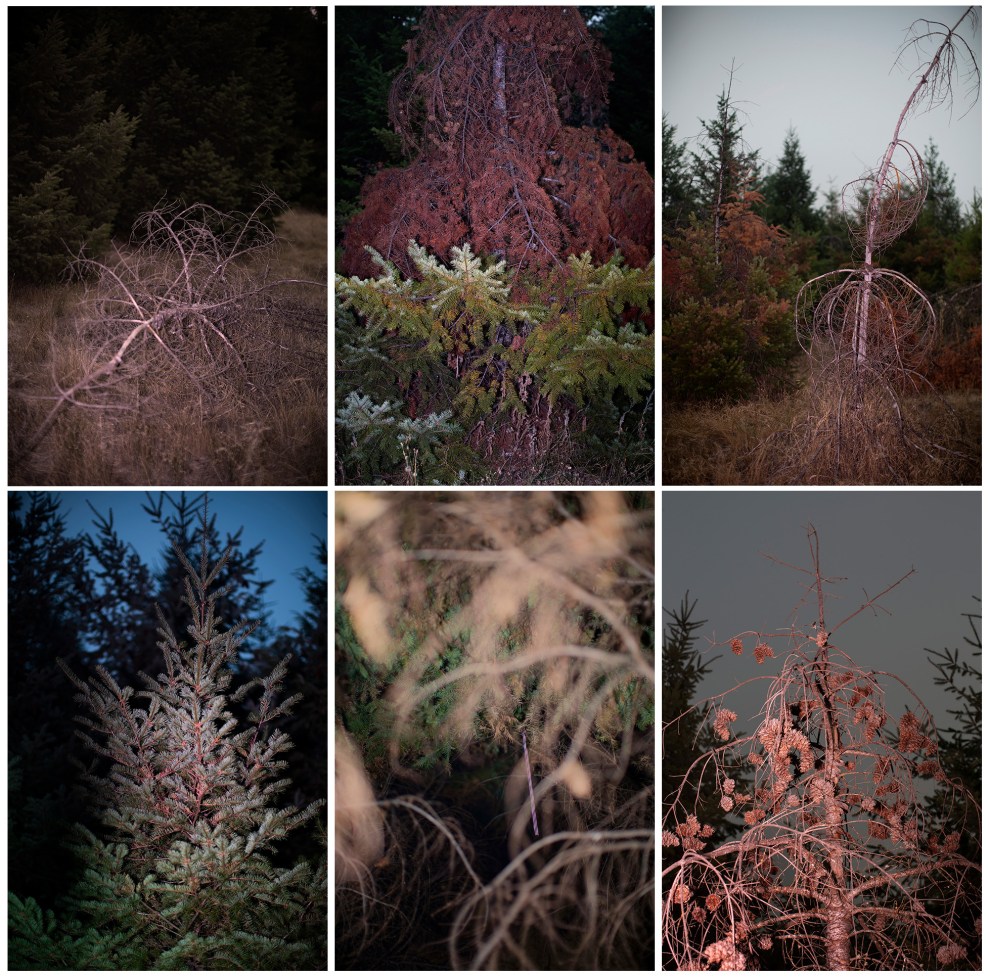
Unlike humans, most trees are long-life species, ranging from the yellow birch, which lives roughly 150 years, to the bristlecone pine, the oldest known of which is nearly 5,000 years old. Forests are the trees’ complex civilization, functioning not unlike human cities: a community of beings that talk to one another and organize and defend themselves and create offspring and bid farewell to their dead. In this way and many others, recent research has revealed, trees are spellbinding, rife for anthropomorphism. They tend to live in interdependent networks, like families, where, with the help of symbiotic fungi, scientists like Suzanne Simard have discovered, they care for their sick, feed one another, and, like a mutual aid society, share resources with those in need. Trees of the same species—and sometimes even those across species—tend to respect one another’s personal space, shifting their growth patterns so that everyone gets enough sunlight. Trees are also adept community organizers who know how to band together to crowd out competitor trees and guard against other threats. When a pest comes, trees can issue chemical warnings to one another so they can launch their defenses. Trees can also register pain. Scientists have found that their root networks, which work with the underworld organisms of fungal mycelia, seem to hold intergenerational knowledge, like a collective brain. Read enough about the mesmerizing science of trees and one begins to feel certain that, if humans behaved like a healthy forest, we’d be far better off—and that we wouldn’t be in our current climate mess in the first place.
Left to their own devices, forests migrate on a near-geologic scale. But people have been moving trees for our own purposes for thousands of years. We’ve done this in small doses, such as planting trees in city gardens or backyards for shade and aesthetic delight, or planting a wall of cypress along a tract of farmland to block the wind. We’ve also moved trees on a far more substantial scale, to a range of outcomes. While apple trees originated in Central Asia, early settlers brought seeds to the Americas and infamously scattered them throughout what is now the United States, where apple pie is now both a signature dessert and a cultural symbol.
Such interventions haven’t always panned out so well: In 1895, the emperor of Ethiopia ordered the planting of fast-growing eucalyptus trees imported from Australia so people would have abundant firewood. But the thirsty eucalyptus crowded out existing trees, and parched once-fertile farmlands. (Eucalyptus trees are also invasive transplants in California, though they have also become critical nesting habitat for the threatened monarch butterfly—the web of interconnectivity is a tangled one.) And in 1904, US foresters began planting Japanese chestnuts to cultivate for wood, which brought chestnut blight to their North American cousins ill-equipped to fight the fungus; by 1940, most adult chestnuts were gone. The movement of trees, scientists caution, must be done with extreme care—and based on history, many are hesitant to do it for fear of throwing off the delicate balance of an existing landscape.Three Ways Humans Move Forests»»
Assisted Population Migration Trees or their seeds are moved from one place where they traditionally grow to a new place that’s also within the historical range of their species. Not only is this considered the least risky type of assisted migration; it’s also the one that scientists in the United States and Canada have tested out the most.
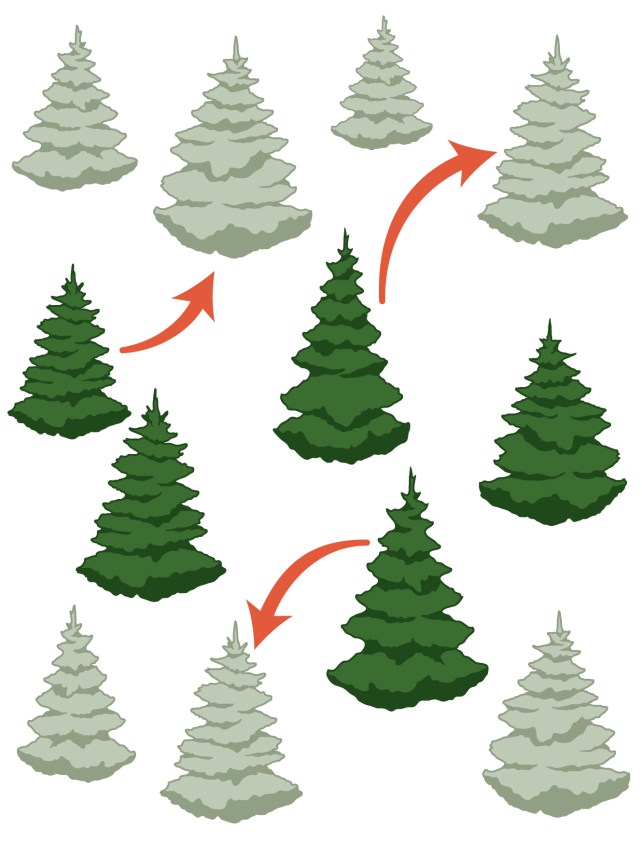
Assisted Range Expansion Think of this as sylvan sprawl: To increase the area currently inhabited by a given species, scientists plant it beyond its traditional boundaries—farther than where it would have otherwise naturally lived. Because range expansion introduces new trees to places they’ve never lived, there is some risk of disturbing the balance of the new habitat.
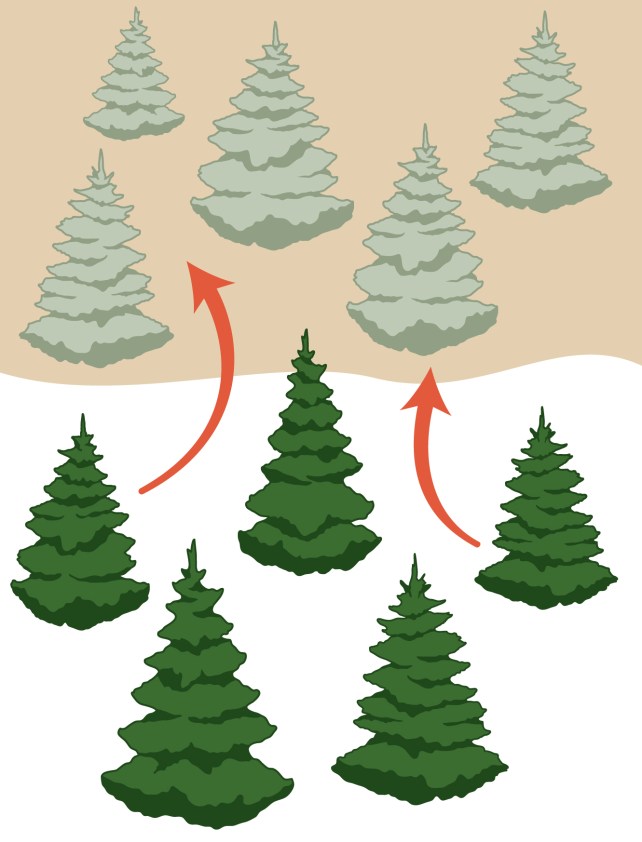
Assisted Species Migration Species are transported from their native habitat to regions where they’ve never lived—or haven’t for millennia. The risk here is substantial: These invasive species could weaken or wipe out native ones, but it might be the only chance for trees in critical need of a lifeboat.

Illustrations by Brown Bird Design
Proponents of assisted migration claim that this balance has already been upended by climate change. They also stress that assisted migration is an umbrella term for a range of activities, some way more far-reaching than others. The most drastic intervention is known as assisted species migration, which transplants species of trees from places where they naturally occur to faraway places where they do not. Then there’s assisted range expansion, which plants trees slightly outside their naturally occurring territory. The strategy involving the least human intervention is known as assisted population migration, which, like St. Clair’s studies of Douglas fir, plants trees of a single species with certain adaptations to a new location where other members of that same species already live. Most scientists advocate the latter two strategies and consider the first one too extreme.
So how to safely move a population to a new habitat—and to know how far to do it, and how fast? “If I knew the answer to that,” Forest Service scientist Kas Dumroese told me, “I’d have the Nobel Prize.” To find out which plants are best suited to which environments, scientists tend to use something called the Common Garden Study, which, like the artificial forest I visited in Oregon, plants flora from a wide range of locations—and thus adapted to a range of conditions—on a single plot to study their response and growth patterns. What scientists have found in most assisted migration garden studies is that the trees that do best are those whose parents and ancestors thrived in similar terrain.
If you move a population of trees adapted to a particular climate too slowly, it’s bound to succumb to the hotter, drier conditions brought on by climate change. But move it too fast to a colder, wetter climate, and the trees might fall victim to too much frost, or to root rot in damp conditions that make them vulnerable to pests. Shifting trees that can handle midcentury climate projections—so new forests are adapted to the temperatures of roughly 2040 to 2070—seems to be the Goldilocks balance that will ensure a population’s survival.
But there are other important considerations, including the symbiotic relationship between soil fungi and trees. Simard, the author of the recent bestselling book Finding the Mother Tree, explains that, while trees will likely find some symbiotic mycelium as long as they are moved within their species’ existing range, that mycelium might not be the best adapted for their needs. Trees can’t be seen as growing in isolation, but need to be considered in terms of the overall health and relationships of a larger ecosystem. “There’s a lot we don’t know,” she told me. Assisted migration “is risky, but, you know, we also have no choice. We have to start experimenting with this. We have to start moving things around and watching and seeing how they do.”
The Forest Service scientists who study assisted migration couldn’t agree more, and they hope that the agency’s forest managers will start using this strategy in actual forests. Despite decades of research, the Forest Service has rarely put assisted migration into practice, in part due to some foresters’ and scientists’ resistance to moving trees outside their agreed-upon range. In the 1930s, the Forest Service created the idea of seed zones—mapping the landscape into areas “within which plant materials can be transferred with little risk of being poorly adapted to their new location,” as the agency states on its website. Ever since, forest managers have stayed loyal to these zones when selecting seeds for planting.
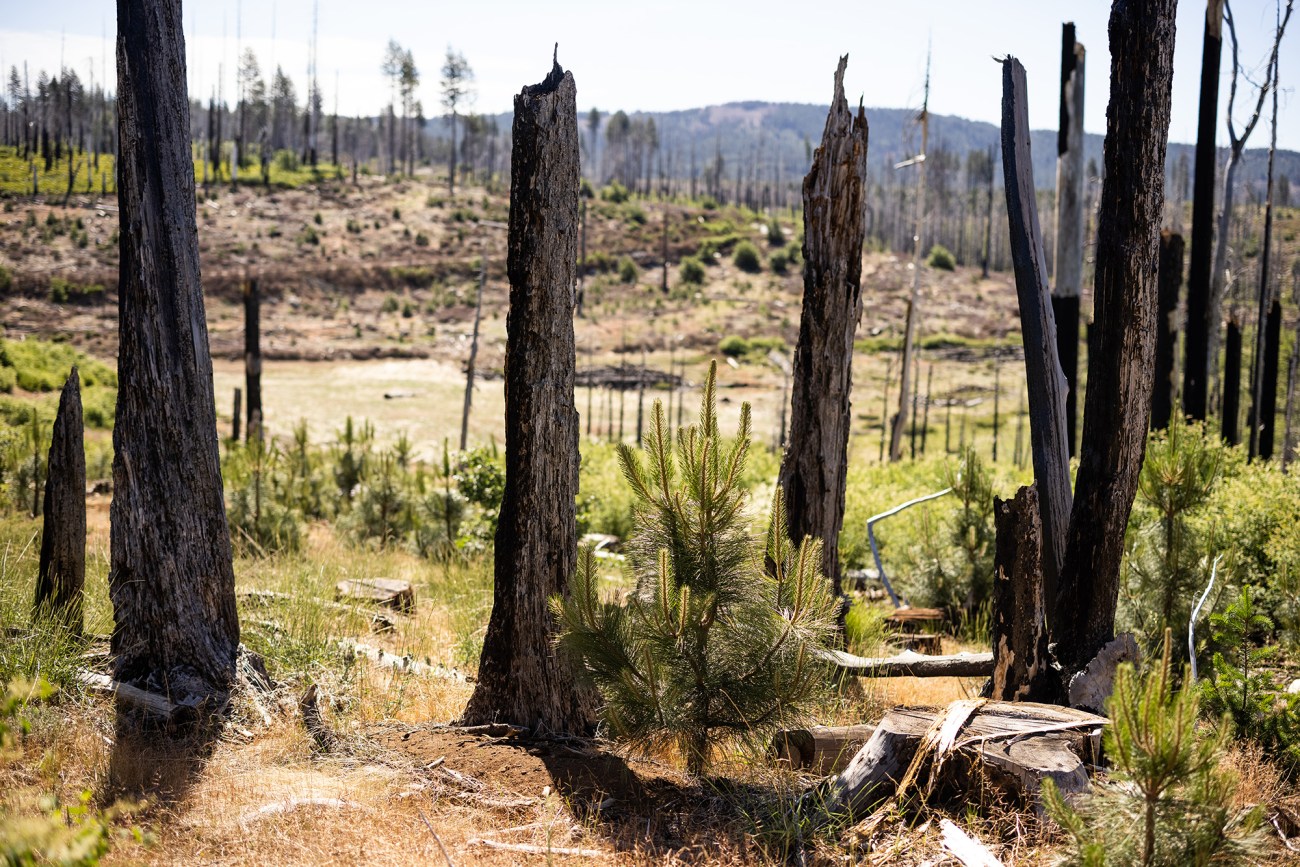
While assisted migration isn’t strictly prohibited by the Forest Service Manual and its accompanying handbooks—the official policy documents that, as Forest Service land manager Andy Bower explains, guide “every aspect” of how the agency operates—it isn’t encouraged, either. Last fall, Bower, St. Clair, and five other forest geneticists in the Forest Service proposed changes to the manual that include assisted population migration and, in some cases, slight range expansion, as forestry strategies. If their recommendations are accepted, it could drastically accelerate the use of assisted migration nationwide.
The Forest Service doesn’t have to look far for an example of a country taking a more aggressive tack: Canada is substantially ahead of the United States in research and implementation of assisted migration. This is, in part, a result of urgency. In the early aughts, aided by worsening climate change, lodgepole pine forests were devastated by invasive bark beetles and massive wildfires. This was also true in the United States, but when it happened in Canada, the country acted far more aggressively. “It was huge,” Greg O’Neill, a scientist working for the Canadian Forest Service, told me, “like they got hit by a sledgehammer. It really woke up the forestry community.” The Forest Service of British Columbia launched the Assisted Migration Adaptation Trial, or AMAT, in 2009, planting roughly 153,000 trees to see how each would fare in different climates. With more than a decade of results, they have begun to use this data to reforest areas that have been logged or burned.
This is not to say that the method should become the land management strategy in all or even most scenarios. Moving species across a landscape in response to climate change, Dumroese says, should be undertaken according to the Hippocratic Oath. “We’re talking about making some decisions that have some implications that we may not understand or even be recognized for 100 years,” he said, “or even longer.”
One of the troubles with assisted migration is that it’s difficult to know what future climate to plan for. Human choices are hard to predict. The adoption of a Green New Deal, for instance, would significantly affect climate modeling, as would the reelection of Donald Trump in 2024 or the continued reign of Amazon-destroying Jair Bolsonaro in Brazil.
But even in the most optimistic of climate scenarios, the forests need to get moving, from south to north, from lowlands to highlands, so that our landscapes remain populated with trees.
“It’s almost like we have this temporal-centric view of nature,” O’Neill said. “A lot of people view climate change as something that’s going to happen, not something that has already happened.” And though all trees can generally survive a change of 4 degrees Fahrenheit in either direction, O’Neill reminds me that 2.7 degrees—the amount that the climate has already warmed in the past century—is a cataclysmic change of circumstances from a tree’s perspective. Seen this way, he said, “these trees are already a long way from home.” If all we do is help them get back to the kinds of habitats they’d lived in before the climate began to change so rapidly, he added, “I think we’ll be doing a great service.”
In May, a few weeks before driving to Oregon, I accompanied Forest Service scientist Jessica Wright from her research station in the Sierra Nevada foothills up Route 50 and into the mountains of the Eldorado National Forest, one of the most ecologically diverse tracts of land in California, spanning nearly 1 million acres. The road wound us upward into the rolling expanse of the Sierras, where towering green pines spread in all directions. Such sights always reminded me of the state’s largesse, and I used to find them transcendental: the sanctity of open space, the vastness of the landscape a mirror for the vastness of the human spirit. But now, this feeling is accompanied by a twin coil of fear. Fire. Those trees are exquisite fuel, and it all feels doomed to burn.
We turned onto a dirt road and knocked our way through the forest. After a few minutes, the trees thinned; the lowest branches of ponderosa pines and Douglas firs were charred, and the blackened sticks of former trees pointed skyward like bayonets. The road took us to an open clearing, bare and treeless like a wound. This was the site of the King Fire, which destroyed roughly 250 square miles of the central Sierra foothills in 2014, and it was only now, seven years later, looking green again.
A few years back, Wright started talking to a Forest Service program manager named Dana Walsh about the prospect of an assisted migration research trial on a tract of land that Walsh oversaw—and they decided to plant along this 12-acre patch that had burned. In the winter of 2019, they sowed their 1,200 trees sourced from 24 origin populations. Their hope is to convince other forest managers that assisted migration can be used to replant burned forests in the future—instead of reforesting strictly with local seeds. And several Forest Service scientists, including Wright and St. Clair, are building new seed selection databases that map climate predictions with seed source adaptations, should assisted migration finally be put into practice in the States.
Wright, who has hip-length hair and seems equally at home sporting a hard hat and presenting at a conference, is particularly optimistic about the prospects of planting in burn zones. If a forest will be replanted anyway, why plant what was already there and burned, when we can reforest these burn sites—which have grown all the more common, and so much bigger—with trees that will be better suited to that future in 30 to 50 years? A stressed forest brings diseases and pests, which kill trees, offering more kindling to burn. The healthier a forest, the less likely it is to catch fire.
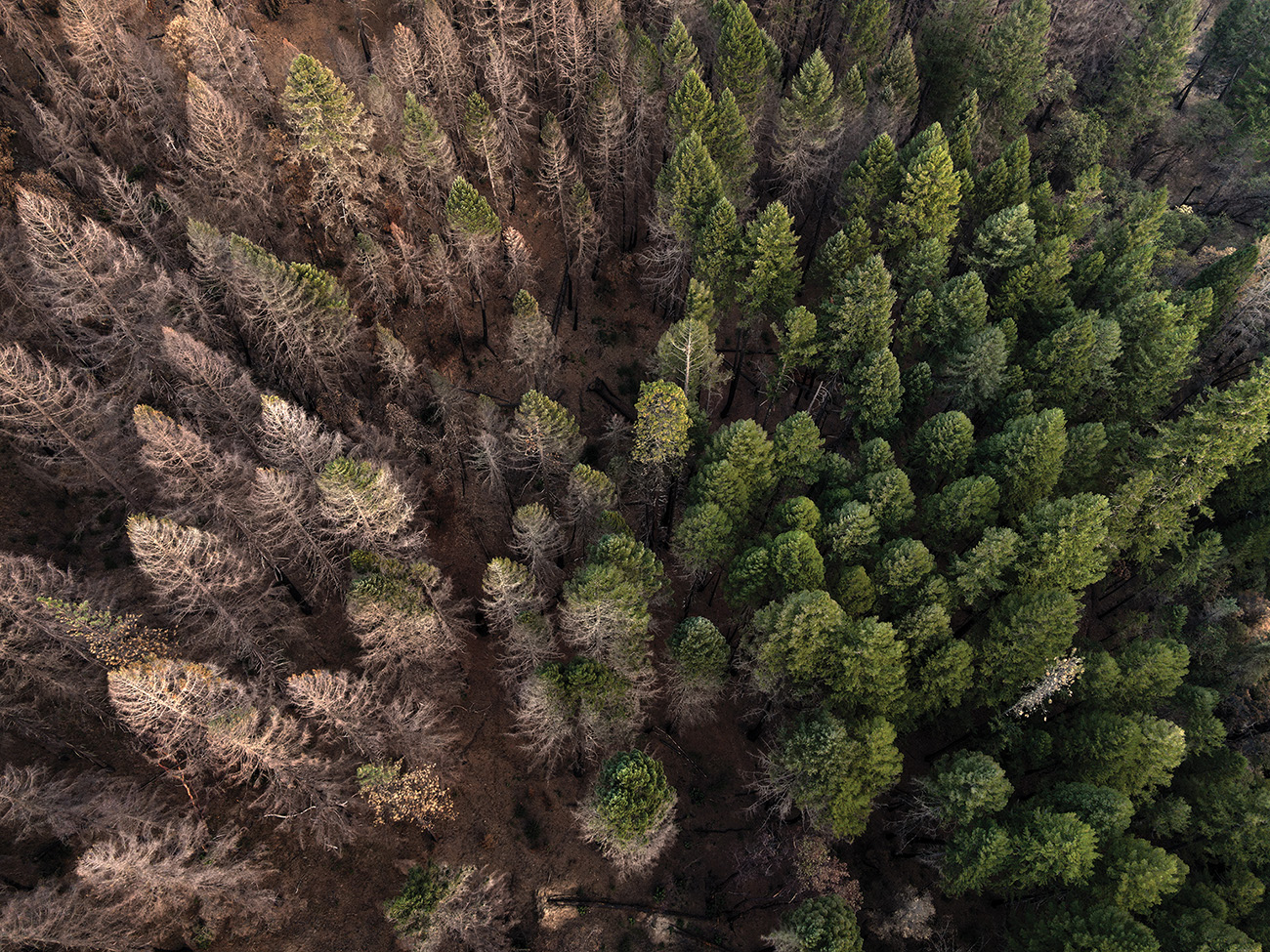
Assisted migration “is risky, but, you know, we also have no choice.
We have to start experimenting with this.
We have to start moving things around and watching and seeing how they do.”
Burn zones, like this one seen from a drone in California’s Shasta-Trinity National Forest, offer a unique opportunity to create the forests of the future. As assisted migration has gained more traction, researchers believe burn zones are prime spots to plant trees that will be adapted for the warmer climates of the middle of the century—and beyond.
Along 12 acres of the King Fire site, Wright and her team had planted two kinds of pine: ponderosa—which grow up to 200 feet tall with thick, striated bark—and a type of sugar pine resistant to white pine blister rust, a fungus decimating western sugar pines. To mimic nature, the trees had been planted somewhat willy-nilly along the hillside, as they would grow in the wild. We walked along the planting site, where I tried to spot the trees; at only two years old, the saplings were not much higher than my ankle. Some hadn’t made it at all, and some were still slight wisps of life, while others were growing strong and burly.
I asked Wright what she made of the differences in growth. She laughed.
“It’s too early to say,” Wright told me.
But weren’t they impatient, I wanted to know? I was. Why was this tree, on the lower slope, doing so beautifully, its tiny trunk much thicker than the rest, its needles skewering outward like porcupine quills, its yellow-green buds promising new growth?
Wright countered that it’s not until about 10 years into a study that the data starts to be meaningful. “That’s when I start to believe it,” she said. So many things could happen between now and then, and early growth might not end up meaning much. After all, those dead Douglas firs that had so rattled me in Oregon had done great the first few years of the study.
We found some shade under the trees that had survived the 2014 fire, and sat down for lunch. To consider the future of forests is to slip into a timeline so abstract that it’s hard to conceive, but scientists like Wright are in it for the long haul, imagining a lifespan far beyond their own.
“I won’t see this big tall forest we’re planting now,” she said. Her kid might see it, or perhaps her grandkid. Tending to any kind of future is a gesture of optimism, she concedes, particularly such a distant one. “But I’m good with that.”
As a member of the living, it can be difficult to understand how unlikely it is, statistically speaking, to become alive. A healthy beech tree, explains Wohlleben in The Hidden Life of Trees, will produce roughly 1.8 million beechnuts in its lifetime. “From these, exactly one will develop into a full-grown tree,” he writes, “and in forest terms, that is a high rate of success, similar to winning the lottery.”
For Joshua trees, the odds of successful reproduction are even longer. For a Joshua tree to be born—a tree that lives in far starker conditions than the beech—its mother has to flower and seed when it reaches sexual maturity. The seed, which resembles a flat puck of black putty smaller than a dime, has to find a home conducive to its germination and bloom. That’s hard enough in the dry expanse of the desert, and harder still as the landscape warms. Its best-case scenario is to find its way to a spot beneath a nurse shrub or blackbrush, where it can germinate protected from the chomp of roving jackrabbits. It would particularly benefit from finding a spot atop a symbiotic soil fungus that lurks beneath the sandy loam and can help the baby Joshua tree grow. If the tree makes it past the perils of early life, it needs another 30 to 60 years before it’s ready to reproduce. Then it would rely on the yucca moth to pollinate it; otherwise, it won’t bear fruit. Then and only then, after this confounding and unlikely gauntlet has been run, will a Joshua tree be able to set seed, the whole tenuous cycle repeating itself.
Scientists have mapped Joshua tree survival against the most dire climatic conditions—i.e., if humans continue at our current rate of consumption and emission—and found that by the year 2100, essentially zero Joshua tree habitat will remain in California’s Joshua Tree National Park, even for trees that are already among the most drought-tolerant.
Lynn Sweet, a plant ecologist who studies Joshua trees at the University of California, Riverside, told me that her team calculated that, under more mitigated scenarios in which carbon emissions were reduced, “we could preserve up to 20 percent or so of habitat in the park and the surroundings,” assuming the moth and mycelium make it in this scenario, too.
When it comes to conservation efforts, humans most often think of the forests most dear to them—the places they grew up visiting, the places where they got married or take their beloved weekend hikes, the national parks known for their iconic trees. These places—Sequoia National Park, Olympic, Muir Woods, the Everglades—loom large in our collective consciousness. “I often joke with reporters,” Sweet told me, “that no one is coming out to do a climate change article on the blackbrush bush,” an equally imperiled species in the desert.
Joshua Tree National Park is central on my personal map of sacred places. It was the first place I went backpacking as a kid, the first place I slept under the stars, and a place I’ve returned to again and again to reattune with the world. The Joshua tree’s silhouette is imprinted on many significant memories throughout my life—these are trees I really, really, really want to survive.
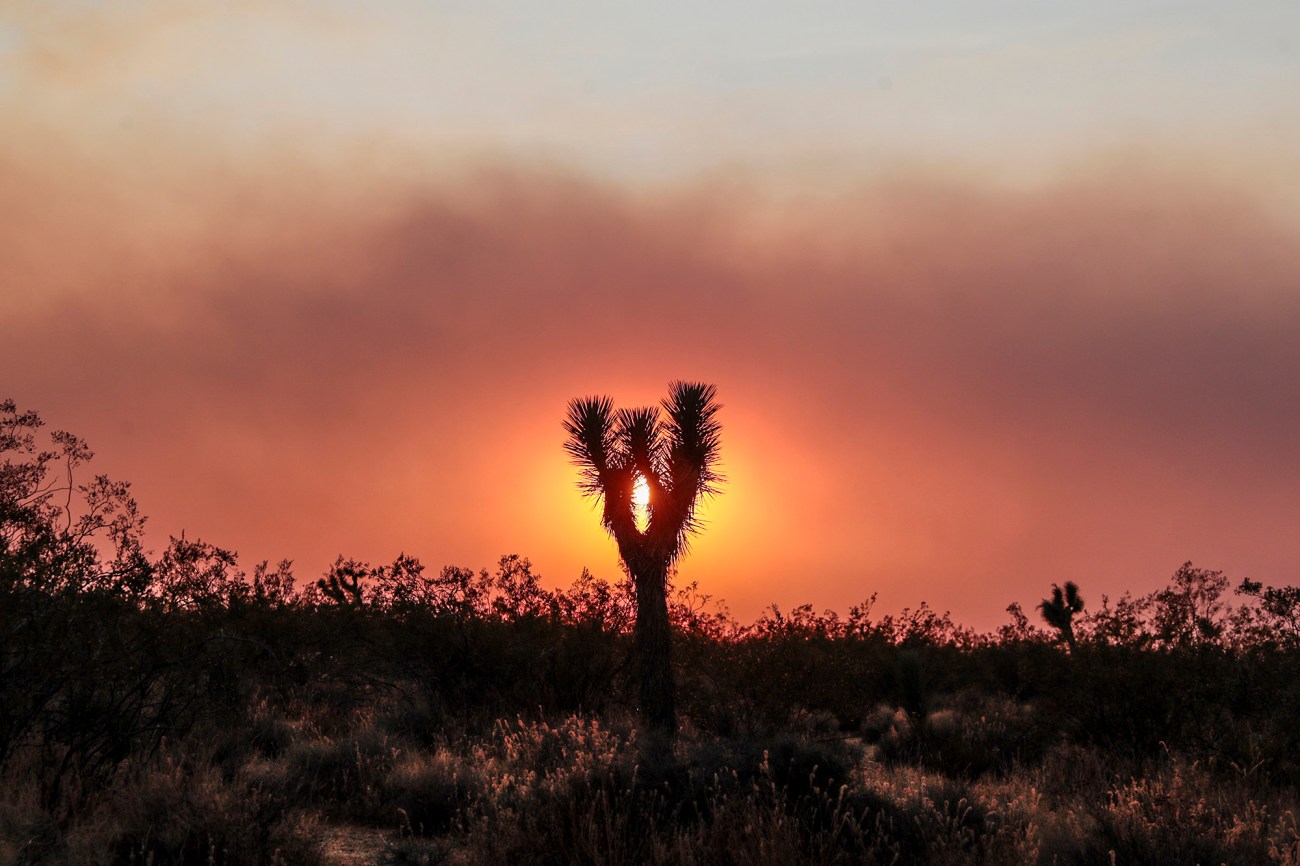
After getting vaccinated last spring, I headed down for a few days in search of desert light and those fabled trees. I drove from the south end of Joshua Tree to the north, moving through a low, flat valley where Joshua trees and cholla clustered in mighty, baffling stands. The Joshua trees here in the valley looked healthy enough, but botanists know better: Look closely, they told me, and you’ll see there are no young sprouting among the noble elders. This was a forest of childless parents, living their final days as the last of their kind to call that spot their home.
Sweet had directed me to visit Black Rock Canyon, where the healthiest of Joshua trees were now finding space to grow. Here we were at a higher elevation than the park’s sweeping flatlands, meaning it was cooler and slightly wetter. “They’re essentially running uphill,” she told me, on an intergenerational march toward higher ground. I took a long solo hike through these highlands where hundreds of Joshuas stood. The trees were lovely to behold from all angles, like benevolent apparitions from some absurdist underworld. But the best view was from above: beholding all those Joshua trees across the valley floor that were thriving, surrounded by their young, with room still to move upward. The problem with up is there’s only so far to go before it’s just sky.
The living will do whatever they need to survive. In the apocalyptic grove near Medford, I had seen one desiccated former tree whose branches were covered in hundreds of cones still affixed to it like Christmas ornaments. St. Clair explained that this behavior was normal enough for a tree in distress. Sensing it will die, the tree bursts forth into cones in a frantic final act of hope: not so much for itself, but for its species.
I left the desert like I’d left Oregon, having seen what I’d come to see: the future. There wasn’t a single version of it, but many. Another quote St. Clair likes to share is by the late forester and politician Gifford Pinchot: “The vast possibilities of our great future will become realities only if we make ourselves responsible for that future.” If we look into the crystal ball, we see ourselves peering back at us in search of answers to the same questions.
